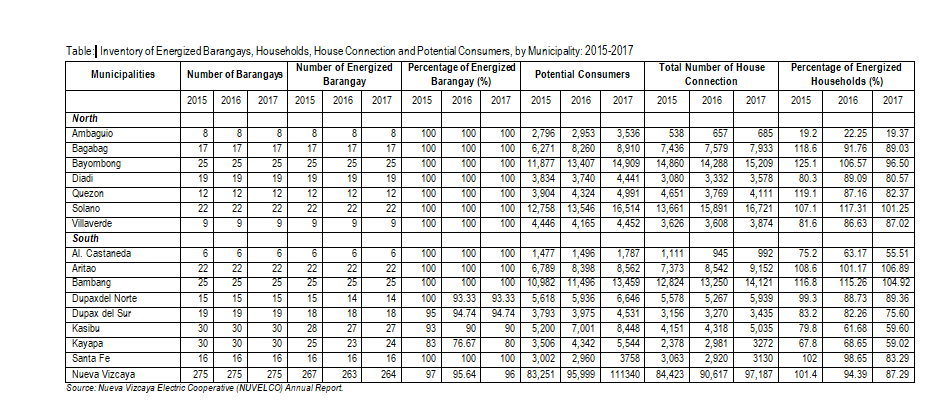5.1 Primary Sector
Agricultral Crops
-Palay
The provincial palay production of 0.21M from 2011 generally increased to 0.26M in 2017 with an annual average rate of 3.89%. Likewise, the production area expanded by 1.89% from 55,999 to 62,324 hectares. The mentioned increases translated to a higher average yield from 3.9 MT in 2011 to 4.38 MT in 2017. For the region’s data, the highest average yield was recorded in year 2017 at 4.53 which is also attributed to the increase of the palay production and the production area.
Note that the displayed data in Table is the PSA (countrystat) data on potential area for palay production on 2 cropping seasons. This means that a land area planted and harvested twice will be counted twice as well. Thus, the total of 62,324 production area hectares (i.e. 2017) refers to 31,162 hectares planted in the 1st cropping season, then replanted for the 2nd cropping season (31,162 x 2 = 62,324).

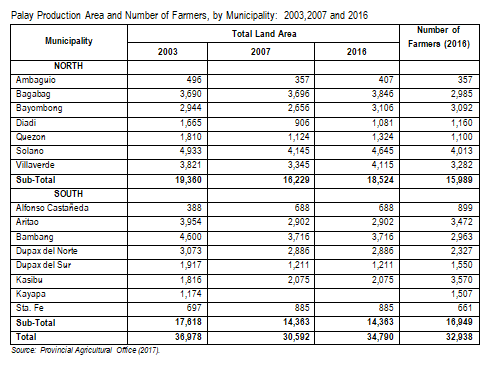
As to the actual area planted with palay, the total area in the south section of the province was relatively higher than that of the north on the 3 years displayed in Table. The municipalities of Solano, Villaverde, Bagabag, Bambang and Bayombong were listed as the top 5 towns with larger land areas. About 15,989 farmers are farming on the nothern sector of the province while a total of 16,949 are on the south which totaled to 32,938.
Livestock and Poultry
Hogs (combined backyard and commercial) is the largest among the livestock industries in the province for the last 7 years with an average percentage of 44% of the total number of livestock. Following it are carabao at 20% of the total, cattle at 20 % and goat at 16%.
Of the average total number of hogs from 2011 to 2017, 84.86% are backyard-raised while the remaining 15.14% are commercial . For the cattle industry, backyard raising accounted to only 78.7% and 21% are commercial. A very high percentage of backyard- raised goats was recorded on the same period at 97% which resulted to a 3% portion for the commercial ones. Carabao livestock industry registered the highest backyard raising percentage at 99.7% as shown in Table. To simplify, dominant in the province is backyard raising.

The provincial palay production of 0.21M from 2011 generally increased to 0.26M in 2017 with an annual average rate of 3.89%. Likewise, the production area expanded by 1.89% from 55,999 to 62,324 hectares. The mentioned increases translated to a higher average yield from 3.9 MT in 2011 to 4.38 MT in 2017. For the region’s data, the highest average yield was recorded in year 2017 at 4.53 which is also attributed to the increase of the palay production and the production area.
Note that the displayed data in Table is the PSA (countrystat) data on potential area for palay production on 2 cropping seasons. This means that a land area planted and harvested twice will be counted twice as well. Thus, the total of 62,324 production area hectares (i.e. 2017) refers to 31,162 hectares planted in the 1st cropping season, then replanted for the 2nd cropping season (31,162 x 2 = 62,324).
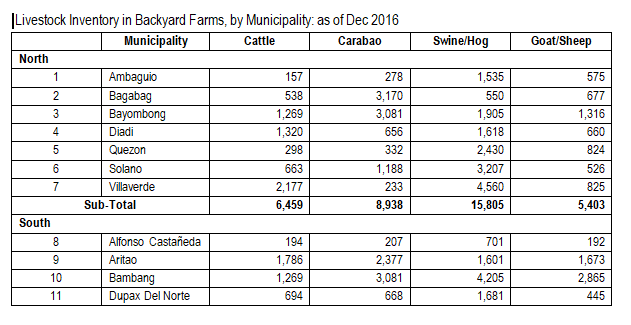
With nearly 81 million of animals slaughtered in the entire Philippines for the past 7 years, swine accounted to a percentage of 92% of the total which is approximately 75 million. Slaughtered cattle, carabao and goat add up to only 6.4M heads equivalent to the remaining 8%. The portion of slaughtered animals in the region only comprised about 4.5% equivalently 3.6M. As to the provincial data, slaughtered animals were dominated by swine which constituted 95% of the total. It is followed by cattle, carabao and goat..
More swine are slaughtered in the province in year 2017 at 75, 706, 6 thousand higher compared to the record of the previous year. For the slaughtered goats, a higher figure was listed in 2016 at 63 heads which dropped by 29 on the succeeding year. As for cattle and carabao, the data on the latest year was the highest on the 7-year period.
Fisheries
The area devoted for the fish industry in 2015 reached 331.36 hectares which expanded by about 104% or an increase of 169.26 hectares from the data in 2010. Kayapa registered the largest area with 54 hectares followed by Bagabag with 46.01 ha. and Diadi with 42.5 ha. On the contrary, the top 3 smallest areas are listed in the towns of Alfonso Castañeda, Santa Fe and Ambaguio with 4.23 ha., 3.20 ha. and 1.20 ha., respectively.
As displayed on Table, more farmers are engaged in fish farming in the towns of Kasibu, Bayombong, Aritao, Solano and Dupax del Sur. The municipalities with the least number of fish farmers on the other hand includes Ambaguio, Bambang, Alfonso Castañeda and Quezon which added up to only 198, 38% of Kasibu’s figure.
The estimated volume of production in the fisheries sector combined inland and aquaculture was estimated at 1,699 metric tons. With the given total, 49.7% are aquaculture-produced which equates to 844.53 MT, about 12MT lower than the production in the inland fisheries.
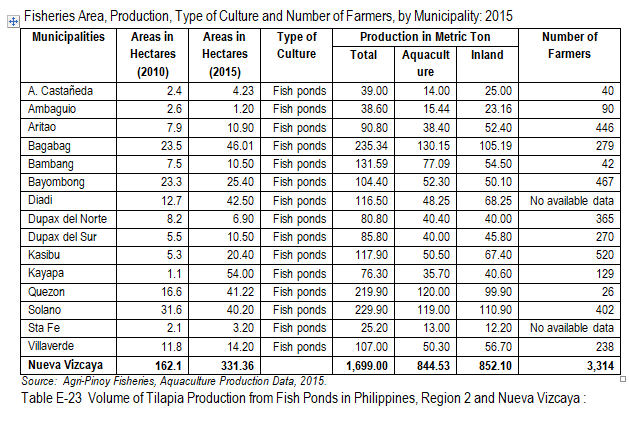
Forestry
The area devoted for the fish industry in 2015 reached 331.36 hectares which expanded by about 104% or an increase of 169.26 hectares from the data in 2010. Kayapa registered the largest area with 54 hectares followed by Bagabag with 46.01 ha. and Diadi with 42.5 ha. On the contrary, the top 3 smallest areas are listed in the towns of Alfonso Castañeda, Santa Fe and Ambaguio with 4.23 ha., 3.20 ha. and 1.20 ha., respectively.
As displayed on Table, more farmers are engaged in fish farming in the towns of Kasibu, Bayombong, Aritao, Solano and Dupax del Sur. The municipalities with the least number of fish farmers on the other hand includes Ambaguio, Bambang, Alfonso Castañeda and Quezon which added up to only 198, 38% of Kasibu’s figure.
The estimated volume of production in the fisheries sector combined inland and aquaculture was estimated at 1,699 metric tons. With the given total, 49.7% are aquaculture-produced which equates to 844.53 MT, about 12MT lower than the production in the inland fisheries.
5.2 Secondary Sector
Mining and Quarrying
Twelve (12) or 44% of the total combined metallic and non-metallic mineral reserves in the region are found in Nueva Vizcaya according to the Mines and Geo-Sciences Bureau. As shown in Table, all the towns in the province are endowed with at least 1 rich metallic minerals such as Gold, Copper, Gypsum, Silver, Manganese, Lead, Nickel and Molybdenum. Non-metallic minerals on the other hand which includes Sand & Gravel, Limestone, Clay and Silica can be mined from all the municipalities excluding Diadi, Kasibu, Kayapa and Santa Fe.

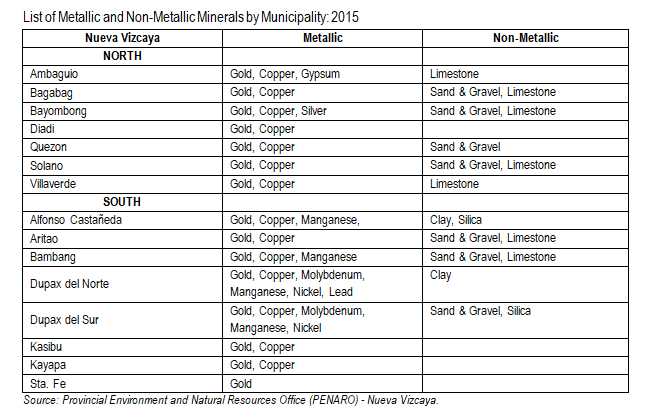

Electricity, Water, Gas Utilities
Nueva Vizcaya Electric Cooperative also known as NUVELCO has energized 267 barangays in 2015 constituting 97% of its target. This percentage dropped to 95.64% equivalently 263 barangays in 2016 then increased to 96% in 2017 with 264 energized barangays.
In terms of house connection, more households were provided with electricity in year 2017. Even so, the number of powered households in 2015 exceeded the target or the potential number of consumers with a remarkable percentage of 101.94%. The percentage of energized households however fell continuously to 94.39% to 87.29% in 2016 and 2017, respectively. Still, massive electrification is needed in the municipality of Ambaguio.
Based on the figures presented in Table, domestic electric power connections to households reached 84,773 in 2015 which increased by about 13 thousand since 2012. Solano being the most populated municipality in the province has the most number of powered households through-out the 5-year period. Ambaguio on the other hand is the town with the least number of households provided with electricity. For the commercial type of power connection, only an increase of about 4 thousand connections was computed from 2012 to 2015. Solano, Bayombong and Bambang being the commercial centers of the province registered the highest number of connections which averagely constituted 61% of the total average number of connections on the same period. The number of industrial connections on the other hand was 683 from years 2012 up to 2015. Only an increase of 4 was recorded from 2012 to 2013. As for the average additional annual connections, the highest figure was listed under domestic followed by commercial and industrial mainly because of the increase of households which needs domestic electrification.
